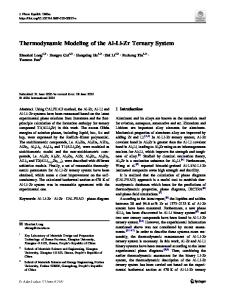Thermodynamic Description of the Ag-Pb-Te Ternary System
- PDF / 631,394 Bytes
- 9 Pages / 593.972 x 792 pts Page_size
- 106 Downloads / 322 Views
Thermodynamic Description of the Ag-Pb-Te Ternary System Wojciech Gierlotka, Joanna Łapsa, and Krzysztof Fitzner
(Submitted June 10, 2010; in revised form July 13, 2010) Tellurium is an unwanted admixture in silver thus it is important to optimize tellurium removal from Ag by controlling its distribution between the liquid, slag and gaseous phases. Consequently, the knowledge of the state of thermodynamic equilibrium which determines the distribution of tellurium between these phases is very important. For its prediction it is necessary to know the thermodynamic description of every phase. In the present paper an attempt has been made to work out a thermodynamic description of the Ag-Pb-Te system. This description is based on literature information and the CALPHAD method. Then, the influence of lead on the vapor pressure of tellurium is analysed.
Keywords
ternary phase diagram, thermodynamic modeling, vapor pressure
tion of tellurium between these phases is very important. In the present paper an attempt has been made to work out a thermodynamic description of the Ag-Pb-Te system, and then to predict the influence of lead content in silver on the vapor pressure of tellurium in the gaseous phase.
1. Introduction 2. Thermodynamic Description of the Phases During the electrolytic refining of copper a by-product known as anodic slimes is obtained and collected in anodic compartments. It is a valuable source of silver, gold, platinum group metals, but also it contains lead, bismuth, antimony, selenium and tellurium. The amount of tellurium in copper anode slimes has been reported to vary from 0.3 to 3%, though sometimes it can reach the level of 10%.[1,2] It occurs principally in solid solutions, but, if the Te content is high enough telluride phases can also be formed. After acid pretreatment the slime is melted under reducing conditions in a reverberatory furnace. The product of this so-called Kaldo process is an alloy containing mainly lead and silver with the additions of a number of solutes. This alloy is next oxidized and during this operation solutes are transferred into the slag phase. Noble metals remain in silver while selenium and some tellurium are removed after oxidation in the form of gaseous species. However, tellurium may still be present in silver. Needless to say, the amount of tellurium in silver exceeding 20 ppm lowers its price and results in difficulty of selling the silver on the market. It is thus important to optimize tellurium removal from silver by controlling its distribution between the liquid, the slag and the gaseous phases. Consequently, knowledge of the state of thermodynamic equilibrium which determines the distribuWojciech Gierlotka, Joanna Łapsa, and Krzysztof Fitzner, Laboratory of Physical Chemistry and Electrochemistry, Faculty of Non-Ferrous Metals, AGH University of Science and Technology, 30 Mickiewicza Av., 30-059 Krakow, Poland; Wojciech Gierlotka, Department of Chemical Engineering and Material Science, Yuan Ze University, # 135 Yuan-Tung Road, Chungli, Taoyuan 320, Taiwan, RO
Data Loading...











